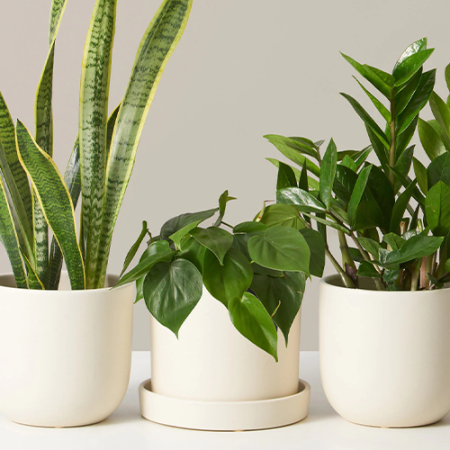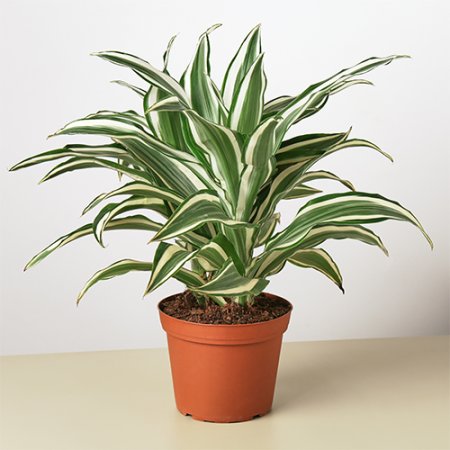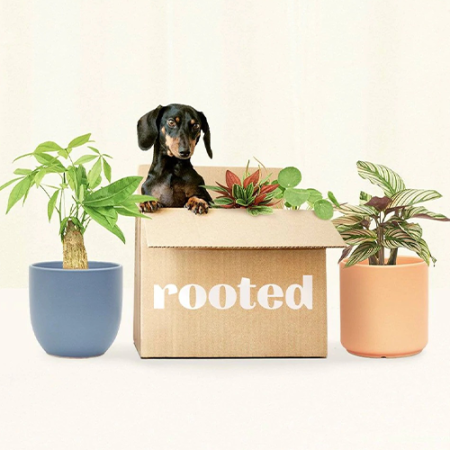We may earn revenue from the products available on this page and participate in affiliate programs.
Reading up on Domino’s shopping guides is like having your own personal product concierge. We do the tedious part—deep-dive research, hands-on testing, and tapping experts for advice—so all you have to do is hit “add to cart.” That’s why we call them Simply the Best.
Adding a little bit—or a lot—of greenery to a room has been a tried-and-true move for Domino’s styling team since, well, forever. (Have you seen our chief content officer’s garden in the sky?) And over the past few years, houseplants have been an extra source of comfort when we needed a dose of nature indoors. In turn, all kinds of plant subscription services have blossomed recently, too.
What’s the benefit of signing up, aside from being able to do it from the sofa in pj’s? Access to a rarer (and larger!) variety of green companions compared to your local hardware store or bodega. Brick-and-mortar retailers often stock up on best-sellers and options that can feel repetitive rather than take a risk on more expensive plants—ones you might be looking for if your home is already dotted with leafy greens. By choosing from one of the best plant subscription boxes we tried, below, you’ll be guaranteed a healthy, quality plant (or you’ll get your money back).
Our Favorites
- Best overall: The Sill
- Best variety: The House Plant Box
- Best for beginners: Horti
- Best for pets: Rooted
Best Overall: The Sill
Cost: $50–$65 | Pot included: Yes | Shipping frequency: Once a month | Number of plants per delivery: One
What we like:
- Most offerings exclusive to subscription only
- A promise of no repeats every six months
- 30-day guarantee
Worth noting:
- Although every plant is a surprise, it will always be a medium, 6-inch (in diameter) indoor plant in a 7-inch ceramic planter.
Why we chose it: A subscription service that ticks every box, perfect for slowly growing your indoor garden.
If you blindly Google “plant subscriptions,” we bet the Sill pops up first—and it isn’t unwarranted. At this point, it is creeping closer to achieving household name status; though born in New York City’s Chinatown by then 26-year-old Eliza Blank, the company now ships green smiles to front doors across the country. And choosing the Sill’s monthly subscription means getting the best of everything a plant box can honestly offer: consistent variety (with selections based on seasonality), quality (if your plant arrives looking a little worse for wear and doesn’t recover within a month’s time, you’ll receive a replacement for free), planter (pick between chic black or cream ceramic containers), and pet-friendly options (for a fee, but no sweat if your feline decides to munch on a leaf). There’s even a care guide to every species the Sill carries. You also have the option to add on accessories depending on your needs that month, from new potting soil to lava rocks.
Best Variety: The House Plant Box
Cost: $16–$99 | Pot included: No | Shipping frequency: The second week of every month | Number of plants per delivery: Varies (one monthly, two for premium or quarterly options)
What we like:
- Variety
- Great bang for your buck
- 30-day guarantee
Worth noting:
- Ships from California and can take up to five business days to arrive
Why we chose it: Quarterly or monthly, large or small, succulents or seeds, pet-friendly or classic, there’s something for every type of plant parent.
When the House Plant Box first started offering a subscription box in 2018, it was just for air plants—you could say it has expanded its offerings quite a bit since then. On the company’s main landing page, you can scroll through every option currently available, including the original. Do you want a large, 10-inch indoor plant? Or just a consistent delivery of cacti? Maybe your idea of starting from scratch is planting seeds suitable for outdoor spaces? There’s a box for that. If you’re a newbie, stick with the classic indoor box. If you’re looking for something a bit more robust, we’d point you toward the quarterly premium option (other boxes ship plants on the small side). Or try something completely new: What really makes the House Plant stand out are offerings you won’t find anywhere else. We’re talking about an aquatic box for the likes of aquariums (and for just $16!) or specifics such as mini indoor plants for the same price. In fact, the low cost is another point worth highlighting. Aside from the premium or extra-large options, you won’t be spending more than $16 (that’s the same price as a standard Netflix subscription), which is typically less than buying a single plant pretty much anywhere, and you can purchase one, three, six, or 12 months at a time.
Best for Beginners: Horti
Cost: $28 | Pot included: Yes | Shipping frequency: Once a month | Number of plants per delivery: One
What we like:
- Secure packaging
- Cancel or skip a month anytime before the 15th
- Pickup available in New York City
Worth noting:
- Small plants
Why we chose it: Boost confidence to grow your green thumb with access to all sorts of educational guides and on-demand custom service.
Horti is just the right thing for your new-to-plants sister (or brother or…), and its products and guides truly make plant care fun. For the first nine months, you’ll receive only plants of the hard-to-kill variety (think: pothos, palms, and prayers), with all the necessary troubleshooting and tips on proper care and maintenance. After month nine, you’ll start receiving more hard-to-find options, like the pilea and calathea, with equally detailed instructions on creating the perfect habitat. The longer you invest, such as for 12 months of shipments ($240), you’ll learn how to propagate and groom your way to a vivacious indoor jungle.
And Horti’s shipping is standout. Boxes arrive neatly packed with recyclable paper, a small heat pack (if shipped during colder months or to wintry destinations), and multiple placards of instructions (and where to go online if you’re in need for more) on how to prep your new friend to be potted. Horti plants come with a puck of dehydrated soil, so add some water for it to grow before placing your plant in its pot, an aesthetic choice that you can also switch up each month. Choose between plain terracotta; signature painted pots in white, yellow, pink, or gray; and even a “naked” nursery option to pick out a vessel of your own.
Best for Pets: Rooted
Cost: $20–$180 | Pot included: No | Shipping frequency: Once a month | Number of plants: One
What we like:
- Flexible payment options and customizable duration
- Have questions? Head to the Discord server for a quick response
- For customers with multiple subscriptions, the team ensures that repeats never happen in a three- to six-month cycle
Worth noting:
- First-time purchases made after the 30th won’t ship in the coming month
- 14-day guarantee
Why we chose it: Sourced from a greenhouse that’s home to more than 300 plant varieties, this pet-friendly box won’t always contain the usual suspects (looking at you, ferns).
When it comes to curating a garden for a pet-friendly household, sometimes it feels like there aren’t a whole lot of options. But if you happen to sign up for more than one offering, Rooted will work with you to ensure repeats never happen with a three- to six-month cycle. Another win? With Rooted you not only can count on variety, but quality. Every plant shipped is homegrown or locally sourced, and you can opt into a carbon emissions offset program, too. Going with the service eliminates having to figure out if the leafy green you love at the hardware store is actually ASPCA-approved. And while there are other pet-friendly options available on this list, you won’t have to pay extra for Rooted’s picks (unlike, say, the $5 extra you have to shell out at the Sill). Plus: If you pay the full subscription price up front, you get 10 percent off! But if you decide you need to skip or pause for a couple of months, just make sure to do so before the 25th to avoid being charged.
How We Chose These Products
There aren’t a bevy of nationwide plant subscriptions available, but it was important for us to try services that weren’t just local to the East or West coasts. We ordered and tested options from different places, prioritizing variety (in both species available and level of care required), value, quality, and—most important—opportunities to learn. Plants are near and dear to both Domino editors and readers, which is why we made sure to suggest companies that will give you virtual advice via video, phone calls, or online portals for how to mend shriveled leaves or spots, then replace or refund you in the rare occurrence your plant doesn’t make it. Plus if you happen to move in the winter and are growing your garden from scratch, there aren’t a whole lot of options during the colder months, and figuring out a way to transport these sensitive greens during frigid temps or snow can stunt growth, whereas the four packages we tried all arrived with a heated pouch (or a couple) that were still warm to the touch.
Our Shopping Checklist
Variety and Customization
Whether you are a burgeoning plant parent or a seasoned expert will likely determine the type of plant box you decide to subscribe to. Thankfully, there are options, whether what’s important to you is the frequency in which orders arrive (choose between monthly, bi-monthly, and yearly) or the type of plants (those most suitable for beginners, or those who don’t want any harm to come to their furry friends). Overall, however, don’t expect to be able to customize what you actually get—part of what makes a subscription box work is the allure of the surprise; if you know exactly what kind of plant you want, then just scoot on over to your local grower, greenhouse, or bodega. In general, you’ll receive a plant or two with each delivery and a card listing how to prep and care for it (think: what kind of sun it thrives in, how often it needs a drink, that sort of thing).
Delivery and Packaging
Much like flowers, it may sound risky to have your leafy greens packed and shipped, but these companies do their best to protect plants during the process, and not one arrived at our editors’ homes looking squished, crushed, or sick—even when making their journey during a cold New York winter. In fact, most plants can survive in a box for up to 14 days, though ideally you’ll want to receive your plant anywhere between one and seven days once it has been picked up by a carrier.
“Our goal is for the plant to be in transit for the least amount of time as possible,” explains Erin Marino, plant expert and editorial lead at the Sill. “To help make that happen, we avoid shipping plants too close to the weekend or on holidays, which may create longer transit times.”
Potting and Planting
After you’ve removed all the packaging and patted any loose soil back in place, you’re ready to finesse, water, and display, according to Marino. But don’t panic if your plant is showing minor signs of stress—she promises this is perfectly normal. “Help the plant perk up from its journey by pruning any leaves impacted during the shipping process,” she offers. “This gives the plant energy for new growth.”
Don’t reach for that water can just yet! Test the soil first (as most subscription services will have watered before shipping) with your finger or a chopstick—if dirt is clinging, you don’t need to water for a few days or even a week, depending on the temperature and humidity in your home.
If it’s dry, give your friend a good soak; Marino recommends using one-third the volume of the grow pot. “Then let the excess water drain out the bottom of the grow pot into a planter or a sink,” she stresses. “Or if you let it trickle into the ceramic planter, make sure to dump that excess water out afterward.” When water pools and lingers, you’re more likely to become a victim of root rot. Luckily, both the Sill and Horti ship with drainage saucers, though you can also take a precautionary measure with a self-watering pot (but skip that if you have a succulent!).
Either way, the planter you choose should be at least 1 inch larger than the nursery pot. This is necessary for a number of reasons: The main one, however, is to let it grow and get comfortable. If you want to plant immediately, gently pull your plant up or cut the plastic with scissors, give the roots a shake, add potting mix, center your plant, and add more soil until it’s tight and secure. Finally, find a spot where your plant will be spending the rest of its days—on the windowsill, kitchen counter, back patio, wherever (as long as it’s receiving the suggested amount of sun). According to the Sill, it will need a few weeks to acclimate to its new home. And don’t repot before it’s too early; wait at least a month after arrival or the summer months.
Ask Domino
Q: What if my plant arrives damaged or dead?
Unfortunately, anything can happen in transit. All of these companies do their best to ensure your greenery will arrive safe and sound, but not all the Bubble Wrap, Hexcel Wrap, or recyclable shipping paper in the world can prevent your plant from being jostled around. Though every box arrives with a “this side up” note to keep soil spillage to a minimum, it isn’t always a guarantee when handled by a delivery service. Depending which service you choose, you might be entitled to a refund, discount, or replacement.
If you order from the House Plant Shop and find cosmetic damage but the root still intact, you can reach out for a 25 to 50 percent reimbursement, depending on how bad it is. Those plants that arrive dead are almost always replaced anywhere, but at the Sill there’s extra reassurance. If your plant has struggled during its first 30 days, you can likely receive a new one for free. The company just asks that you send a photo for proof (or if you live nearby, stop by a local store to assess the issue).
Q: The leaves of my plant are starting to spot and yellow. What do I do?
Sounds like your plant has a fungal infection—that is, if we’re talking about spotting within the leaves as opposed to around the edges (which is more likely a watering problem; you’re probably drowning it or leaving it parched, so poke around in the soil to see how damp or dry it is first). Otherwise, if you’ve made a home for a gaggle of plants, you’ll want to isolate this one from the crowd (yes, bacteria can spread through spores to neighboring greens), then prune the infected leaves. If the spotting isn’t too bad, i.e., hasn’t turned into a gaping hole in your leaf, try spraying everything down with a 1:1 ratio of neem oil and water. Be mindful to test a small patch first, as it can burn some leaves if your mixture is too strong.
To promote a swift recovery, you can also introduce a fertilizer like Kelpy—a liquid supplement derived from kelp in British Columbia that supports new growth, vibrancy, and a resistance to pests. Just mix one tablespoon of the stuff with a liter of water. But in general, the key to a healthy and happy houseplant is consistent exposure to light, temperature, and water. Too much or too little can throw it into disarray, no matter how hearty the species may claim to be.
Q: I don’t exactly have the greenest thumb. Is it worth getting plant insurance?
Plants, like pets, are living, breathing beings that can survive decades when properly cared for. Monsteras? Like 40 years. Snake plants? Give ’em 20. If you’re less than confident in your caretaking abilities but can’t stop eyeing the forever-cool fiddle-leaf fig, plant insurance can help set aside your ownership (and investment!) anxiety. Through Horti, for example, you can choose between two different plans (Plant Reassurance and Plant Resurrection) that will auto renew monthly. They not only quell any nervousness but serve as an educational resource, too, teaching you how to look out for root rot and trap those pesky gnats. Reassurance ($5) is all about preventative care, where plant doctor Chris Satch will diagnose the problem via photo and provide care guidance. Resurrection ($10), on the other hand, will provide a replacement if the issues don’t resolve.
The Last Word
The best plant subscription boxes can spark joy for green thumbs of all levels, whether you’re a novice unsure of what to choose in person; a professional collector who can’t find what they’re looking for at a local shop; or an enthusiast who simply doesn’t live close enough or have the time to drop in to a nursery.





